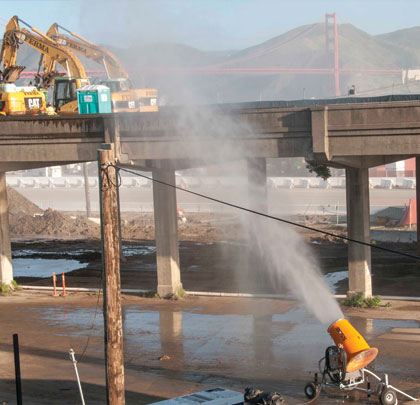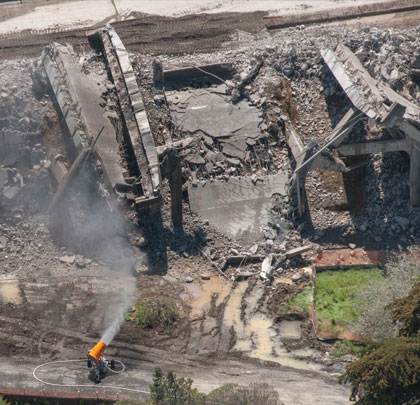Originally constructed in 1936, Doyle Drive is a busy thoroughfare that carries thousands of cars per hour in peak traffic periods. In 1990, it underwent a full seismic evaluation and was determined to have reached the end of its useful service life, deemed structurally and seismically deficient due to the ravages of time and continuous use. Its replacement would be an entirely new Presidio Parkway design, including two short tunnels, a wide landscaped median, and engineered transitions to city streets to ease traffic and improve safety. When completed, the new parkway will also produce a dramatic visual change, as the bulky concrete Doyle Drive structures are removed to reveal striking views of the Presidio and San Francisco Bay.
DEMOLITION FIRST
In the spring of 2010, Phase I of the project got underway, with the construction of a tunnel and detour roadway to shift traffic completely off of Doyle Drive. Demolition of the old structure began in 2012, involving approximately 4,700 linear feet of roadway, including some 150 spans in three distinct structures. Yet the plan required that the road be completely closed for just one weekend to demolish the entire length.
“There was only a 57-hour window to demolish the existing structure and complete construction of the bypass before we had to reopen the roadway to vehicle traffic,” explains California DOT resident engineer Andrew Yan. “The structure was divided into four main components, all to be demolished within the same timeframe. It was a tall order, but we planned out every detail.”
The takedown required a fleet of 40 pieces of demolition equipment, including 20 hydraulic excavators outfitted with a variety of work tools, such as hammers, grapples, pulverizers, and shears. Crews also used backhoe loaders, track loaders, wheeled loaders, and articulated dump trucks, all running continuously to meet the tight deadline.
Because of its proximity to the Presidio, an historic national park that remained open to the public during demolition, the contract called for a dust control plan to prevent all visible dust from leaving the project boundaries while work was underway.
“In some places, the public areas were less than 100 feet away from the demolition activity,” Yan continues. “There’s also a residential neighborhood and business corridor adjacent to Doyle Drive. In addition, we had to consider the nearby marsh, wetlands, and forest, as well as the wildlife within those habitats.”

Demolition of the old structure involved approximately 4,700 linear feet of roadway, including 150 spans, yet the plan allowed complete road closure for just one weekend.
HIGH PRIORITY TO SECURE DUST
With dust suppression such a high priority, the CalTrans researched a number of equipment options to supplement traditional water trucks and manual spraying. “Because we had simultaneous demolition in four distinct locations on this project, we needed dust control over a very wide area,” he observes. “But the manpower we could commit to that was limited. The initial equipment designs we reviewed didn’t convince us that they could deliver the coverage we required.”
Yan remembered that another CalTrans project faced similar dust suppression issues, on the Oakland Bay Bridge West Approach in San Francisco. He knew that engineers had successfully controlled the demolition dust on that job with large atomized misting units from Dust Control Technology (DCT). After reviewing specifications on the various models and discussing the project requirements with DCT, he arranged a rental of eight DustBoss® DB-60s, with on-site training supplied by the manufacturer.
DUST MANAGEMENT BY DESIGN
One of the best-known designs in the DustBoss product family, the DB-60 is a large-scale suppression unit with special atomizing nozzles that create an “engineered mist,” sizing the droplets specifically for optimum dust control (typically 50-200 microns). A powerful 25-hp fan launches the droplets over long distances, allowing one full-oscillation machine to cover nearly 125,000 square feet with a highly efficient dust-trapping mist.
The DB-60 represents one of the few suppression technologies that’s effective on both ground level dust and airborne particles. When particle sizes or service environments dictate, DustBoss designs are also engineered to allow a wide range of customizations, including the company’s VPS Technology (Variable Particle Sizing). Using a variety of nozzle sizes, shapes, patterns, and flow, DCT can tailor the mist output to suit specific dust particle sizes and extreme conditions.
RESULTS
In California DOT worksites, dust control is no longer a luxury but a contractually-mandated component of demolition, construction, and certain types of maintenance work, subject to inspection. “Particularly in the city and greater San Francisco Bay area, dust suppression strategies and techniques are constantly being reviewed and refined,” Yan continues. “Overall, there’s been an increasing focus and scrutiny on developing multi-pronged approaches to site maintenance, including dust management and water pollution prevention.”
With the increase in materials recycling on-site, and trends toward tighter regulation of jobsite effluent of all kinds, industry professionals are more motivated than ever to find efficient, cost-effective methods of dust suppression.
With the significant reduction in airborne dust, Yan and his crews contributed to a healthier workplace on the complex Doyle Drive demolition project, while protecting the surrounding communities and natural environment. ■
For More Information:
For more information on Dust Control Technology, call 800.707.2204, or visit www.dustboss.com.
_________________________________________________________________________
Modern Contractor Solutions, September 2013
Did you enjoy this article?
Subscribe to the FREE Digital Edition of Modern Contractor Solutions magazine.

Airborne Dust Solution


